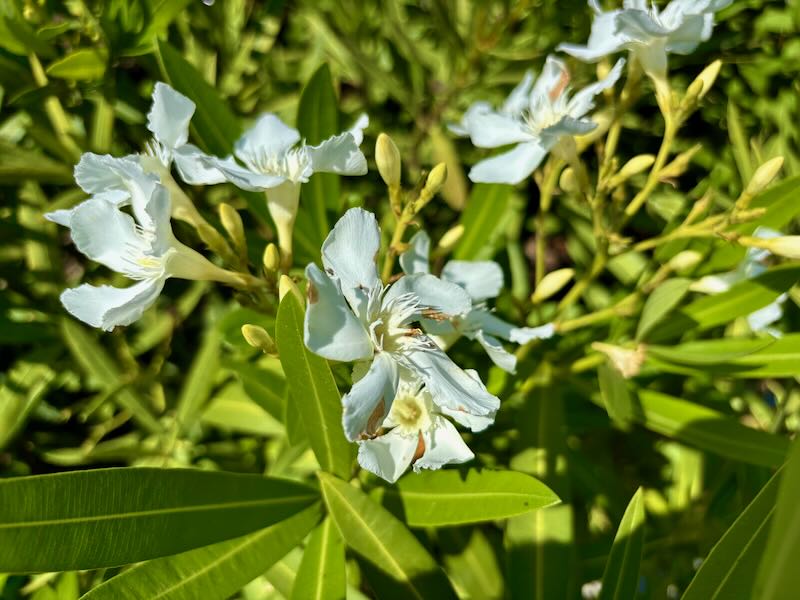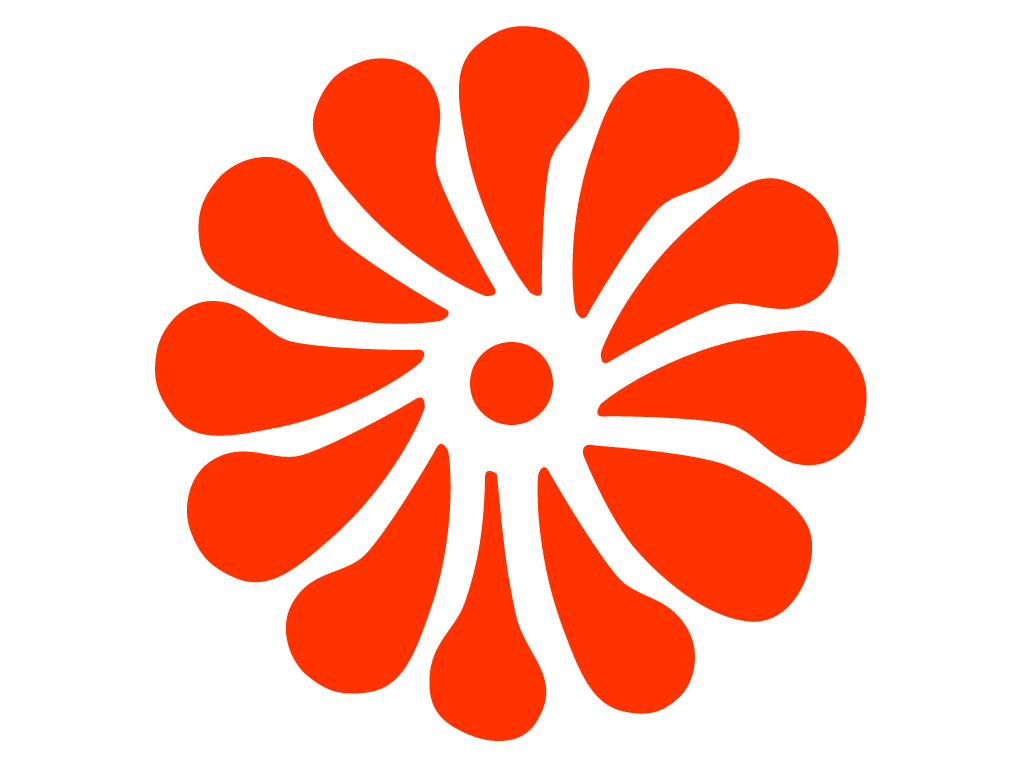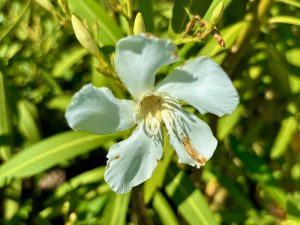Nerium oleander ‘Sister Agnes’: a salt-tough white oleander for hedges, screens, and coastal gardens
Nerium oleander ‘Sister Agnes’ (also sold as ‘Soeur Agnes’, Sister Agnes Oleander, White Oleander, and Mediterranean Oleander) brings clean, snow-white bloom clusters to the hottest, driest corners of the garden. This broadleaf evergreen sits in the dogbane family, Apocynaceae, alongside Plumeria and Mandevilla. It thrives in sun, shrugs off salt spray, and makes fast, dense cover where many shrubs fail. Grow it as a large shrub for privacy or train it as a small patio tree. In warm climates it flowers for months, feeding your landscape with bright color and glossy, lance-shaped foliage.
Meet Nerium oleander ‘Sister Agnes’
Gardeners prize this cultivar for its generous flushes of single, pure-white flowers. Each bloom is about 2.5–3 cm (1–1¼ in) across and lightly fragrant, especially in warm evenings. The petals open from tight green buds and gather in showy clusters at the shoot tips. Beneath the flowers, leathery leaves form in whorls along tough, gray-brown stems. The foliage is narrow and lanceolate, 10–18 cm long (4–7 in) and 1–2.5 cm wide (½–1 in), with a satiny, mid-to-dark green sheen.
‘Sister Agnes’ grows quickly. In the ground, plan for 2.4–4.5 m tall (8–15 ft) and 1.8–3.6 m wide (6–12 ft), depending on climate and pruning. In containers it stays smaller. The habit is upright to vase-shaped when trained, or broad and rounded when left as a multi-stem shrub.
The names and the look
You will see both ‘Sister Agnes’ and ‘Soeur Agnes’ on tags. They refer to the same white-flowered selection. Nurseries also market it as White Oleander, a useful search term if you are matching an existing hedge. Whatever the label, the combination stays consistent: evergreen structure, sun-loving nature, and summer-long white bloom.
Flowering season, fragrance, and repeat
In frost-free gardens, Nerium oleander ‘Sister Agnes’ begins to flower in late spring and continues into autumn. Where summers run long, it barely pauses between flushes. In climates with mild winters, you can catch scattered winter blossoms on warm spells. Deadheading is optional; new trusses form on the season’s current growth whether or not you remove the old clusters. Light fragrance varies with temperature and time of day, and reads as clean and slightly sweet.
Growth rate, structure, and training options
Expect strong juvenile growth. Plants can add 30–60 cm (12–24 in) of height each year once established. As stems mature, bark turns gray and develops shallow furrows. You can keep ‘Sister Agnes’ as a dense shrub by tip-pruning, or select 3–5 main stems and lift the canopy to shape a small evergreen “tree.” The wood responds well to pruning, so you can size it to fit a courtyard, long boundary, or driveway island.
Landscape uses for Nerium oleander ‘Sister Agnes’
Use it where heat, glare, and reflected light defeat fussier shrubs. In coastal gardens, plant a wind-filtered row as a handsome salt-tolerant screen. In inland sites, line a western fence to shade patios from the late sun. Train a single specimen as a patio standard in a large container. Mass several plants on 1.8–2.4 m (6–8 ft) centers for a tall hedge, or plant at 1.2–1.5 m (4–5 ft) for faster coverage. Pair it with other dry-garden stalwarts—Lavandula, Rosmarinus (culinary rosemary), Westringia, Teucrium, and Lantana—for a mixed Mediterranean border that needs little summer pampering.
Environmental tolerances of ‘Sister Agnes’ Oleander
This is a landscape workhorse. It tolerates intense sun, drought once established, alkaline or acidic soils, urban air pollution, wind, and salt spray. It also shows resistance to verticillium wilt, a soilborne disease that injures many woody plants. The main limitation is cold. ‘Sister Agnes’ performs best in USDA Zones 9–11. In upper Zone 8 it may defoliate or die back in hard freezes but often rebounds from the base. Prolonged freezes below about −7 °C (20 °F) can kill top growth.
How to Grow Nerium oleander ‘Sister Agnes’
Light
Plant it in full sun. Give at least 6–8 hours of direct light each day for dense foliage and heaviest flowering. It tolerates light shade, but stems stretch and flower trusses shrink when sun is scarce.
Soil
Place it in well-drained ground. Sandy loam is ideal, yet this oleander adapts to clay if you improve drainage. Work 5–8 cm (2–3 in) of compost into the top 20–25 cm (8–10 in) of soil before planting. Target a pH anywhere from slightly acidic to moderately alkaline (roughly 6.0–8.0). Avoid low, water-holding pockets.
Watering
Water deeply to establish. During the first growing season, irrigate when the top 5–8 cm (2–3 in) of soil dries. After roots spread, shift to deep, infrequent watering. In summer heat, a thorough soak every 10–14 days is usually enough in the ground; containers dry faster, so check them every 2–3 days. Always water at the base to keep foliage dry and reduce disease risk.
Fertilizing
Feed lightly. In most garden soils, ‘Sister Agnes’ needs no regular fertilizer. If growth seems slow in spring, apply a balanced, slow-release product at the lowest label rate, or top-dress with 2–3 cm (¾–1¼ in) of compost and water it in. Excess nitrogen pushes rank growth and fewer flowers.
Planting and spacing
Set plants level with the surrounding soil. Dig a hole twice as wide as the root ball and only as deep. Tease any circling roots, place the plant so the crown sits at or slightly above grade, backfill, and water well. For hedges, space 1.2–1.8 m apart (4–6 ft) depending on how quickly you want a solid wall. For free-standing specimens, allow 2.4–3.0 m (8–10 ft) so the canopy can develop natural proportions.
Pruning and training
Prune right after the main summer bloom or in late winter before new growth starts. For a shrub form, remove a few of the oldest stems at the base each year to stimulate fresh shoots, then tip-prune to shape. For a standard (tree) form, select a central framework of 3–5 trunks, remove lower side shoots gradually over two seasons, and form a rounded canopy at 1.2–1.5 m (4–5 ft). This plant tolerates hard renovation if storms or cold snap damage occurs. Always wear gloves and long sleeves; the sap can irritate skin.
Mulching and weed control
Lay a 5–7 cm (2–3 in) ring of coarse organic mulch around the root zone, keeping it 8–10 cm (3–4 in) off the stems. Mulch moderates soil temperature, suppresses weeds, and conserves moisture. In coastal areas, crushed shells or gravel mulches also work well and reflect sun into the canopy, boosting bloom.
Containers and overwintering
Grow it in a 40–60 L (10–15 gal) pot with large drainage holes if you garden north of Zone 9. Use a gritty, well-aerated mix with 20–30% perlite or pine bark. Water when the top 3–5 cm (1–2 in) of mix is dry. Feed at half-strength every 4–6 weeks from spring to midsummer. Before hard frost, move the pot to a bright, frost-free spot around 4–10 °C (40–50 °F). Water sparingly in winter to keep the root ball just barely moist.
Propagation of Nerium oleander ‘Sister Agnes’
Home gardeners propagate this cultivar most often from cuttings because seed does not come true. Take semi-hardwood cuttings 10–15 cm (4–6 in) long in summer from non-flowering shoots. Strip the lower leaves, rinse off latex sap, and dip the base in rooting hormone.
Insert cuttings into a sterile, free-draining medium of perlite and peat or fine bark. Keep warm—around 21–24 °C (70–75 °F)—and maintain high humidity with a clear cover or intermittent mist. Rooting typically occurs in 3–6 weeks. Hardwood cuttings taken in late winter can also succeed, though root times run longer. Simple layering works outdoors in warm zones: bend a low branch to the ground, wound the underside, peg it into soil, and sever it once it roots.
Pests & Diseases on Nerium oleander ‘Sister Agnes’
Healthy, sun-grown plants in well-drained soil resist most problems. Still, watch for a few issues and act early.
Aphids, mealybugs, and scale. These sap feeders collect on tender shoots and undersides of leaves, excreting honeydew that leads to sooty mold. Start with a strong jet of water to dislodge them. If needed, apply insecticidal soap or horticultural oil, coating all surfaces. Repeat every 7–10 days until clear.
Spider mites. In hot, dry spells, stippled leaves and fine webbing signal mites. Increase humidity by rinsing foliage in the morning. Follow with horticultural oil if populations persist.
Oleander caterpillar (Syntomeida epilais). In subtropical regions (notably Florida and the Caribbean), these orange-and-black larvae can defoliate plants fast. Hand-pick small populations. For larger outbreaks, use Bacillus thuringiensisvar. kurstaki (Bt) on young larvae, reapplying per label.
Leaf scorch (bacterial, Xylella fastidiosa). This serious disease—more common in parts of the U.S. Southwest—causes marginal leaf browning, twig dieback, and decline. There is no curative spray. Remove infected plants and do not replant oleander in the same spot if scorch is prevalent in your region. Clean tools with a 10% bleach solution after pruning.
Fungal leaf spot and shoot blight. Overhead irrigation and crowded hedges increase risk. Improve air flow, water the soil not the leaves, and prune out affected growth. Copper-based fungicides can help protect new foliage in wet summers.
Root rot. Waterlogged soils invite rot. Fix drainage, raise beds, and water less often.
Good cultural care is the best defense: full sun, space for air to move, measured watering, and clean tools.
Safety and toxicity
Every part of Nerium oleander—stems, leaves, flowers, and sap—is highly poisonous if ingested by people or pets. The latex can irritate skin and eyes. Always wear gloves, sleeves, and eye protection when pruning or taking cuttings. Wash hands and tools after handling. Never burn trimmings; smoke can be hazardous. Bag and bin green waste according to local guidelines. Avoid planting where curious children or grazing animals can access it.
Design pairings and siting ideas
White flowers read as cool and crisp in blazing sun. Set ‘Sister Agnes’ against stone, stucco, or dark fencing to make the blooms pop. For a coastal palette, combine with Myoporum laetum, Pittosporum tobira, and Arbutus unedo. For a Mediterranean mix, weave in Lavandula, Salvia officinalis, and prostrate rosemary along the front edge. In hotter deserts, partner with Leucophyllum, red yucca (Hesperaloe parviflora), and lantana for a colorful, water-wise slope. In containers flanking a pool or entry, underplant the standard form with silver dichondra or white bacopa to echo the blooms.
Regional notes
- Coastal gardens: Salt spray and alkaline sand do not faze this shrub. Rinse foliage after the harshest storms and prune wind-tattered tips to encourage fresh growth.
- Humid Southeast and Gulf Coast: Expect faster growth and more pest pressure. Keep hedges open and accessible for inspection. Oleander caterpillar may require seasonal management.
- Mediterranean and West: Drought once established, but spring deep watering improves bud set before the dry season. In areas with known bacterial leaf scorch, consider site history before planting.
- Marginal Zone 8 sites: Plant in a heat-holding microclimate—south-facing wall, protected courtyard—and mulch the root zone each winter with 7–10 cm (3–4 in) of dry material. Be ready to cut back freeze damage in spring.
Quick troubleshooting
- Lots of leaves, few flowers. Increase sun exposure and avoid high-nitrogen fertilizers. Prune lightly after the first flush to stimulate new flowering shoots.
- Yellowing leaves on new growth. Check drainage and watering frequency. Correct wet feet and allow the top few centimeters of soil to dry between irrigations.
- Black, sooty film on leaves. Treat sap-sucking insects (aphids, mealybugs, scale). Wash off sooty mold with a gentle spray once pests are controlled.
- Winter dieback. Normal near the edge of hardiness. Prune to live wood in spring; the plant often rebounds from the base.
- Leaf margins turning brown and crisp in midsummer. Heat and wind stress combined with low soil moisture. Deep-water less often but more thoroughly, and refresh mulch.
At a glance: key specs for Nerium oleander ‘Sister Agnes’
- Family: Apocynaceae
- Form: Broadleaf evergreen shrub or trained small tree
- Size: 2.4–4.5 m tall × 1.8–3.6 m wide (8–15 ft × 6–12 ft)
- Bloom: Single, pure-white clusters from late spring to fall; light fragrance
- Light: Full sun for best display
- Soil: Well-drained; tolerates acidic to alkaline (pH ~6.0–8.0)
- Water: Moderate during establishment; low once established
- Hardiness: USDA 9–11 (with protection in upper 8)
- Tolerances: Heat, drought (after establishment), wind, salt spray, urban pollution; verticillium wilt resistant
- Uses: Hedge, screen, windbreak, median/parking islands, coastal gardens, large containers, trained standards
- Cautions: All parts highly toxic; irritating sap; do not burn prunings
Final notes on Nerium oleander ‘Sister Agnes’
Choose this oleander when you want handsome, evergreen structure and months of white bloom with very little fuss. Plant it in sun. Water it well the first season. Keep your pruning shears handy and your gloves on. With those simple steps, Nerium oleander ‘Sister Agnes’ will deliver a durable hedge, a clean backdrop for colorful perennials, or a bright, salt-proof screen along the coast—year after year.



